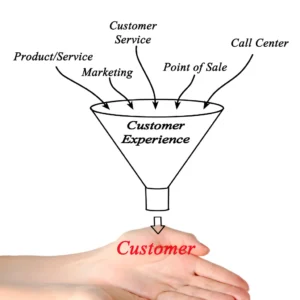
Revolutionizing Retail
AI Tools Unleashing Customer Feedback & Support Excellence
This article explores the transformative domain of “Retail B2C Industry AI Tools for Customer Feedback and Support.”
Integrating Artificial Intelligence (AI) tools has emerged as a game-changer in the ever-evolving retail landscape, where customer satisfaction is paramount.
These tools revolutionize customer interactions, from sentiment analysis and dynamic surveys to automated support and voice analytics. While navigating the complexities of data privacy, integration challenges, and staff training, businesses unlock a spectrum of benefits – enhanced engagement, operational efficiency, and strategic decision-making.
Join us in exploring how AI tools meet the demands of the modern retail environment and elevate customer experiences to new heights.
Table of Contents

Arindam Roy
An Automation Consultant with 25+ years of IT Experience
AI Tool ideas for Customer Feedback & Support
Building a comprehensive Retail B2C Industry AI Toolset for Customer Feedback and Support focusing on highly technical and competitive customers requires careful consideration of each tool’s functionality and integration. Here’s a breakdown of the key features and considerations for each tool:
Sentiment Analysis for Customer Reviews:
- NLP Integration: Implement advanced natural language processing algorithms to accurately analyze and understand customer reviews’ sentiments.
- Platform Integration: Connect with popular review platforms such as Yelp, Google Reviews, and industry-specific review sites to gather feedback from various sources.
- Automated Alerts: Set up real-time alerts for negative sentiment detection, enabling quick response and issue resolution.
AI-Powered Customer Surveys:
- Dynamic Survey Creation: Develop a user-friendly interface for creating dynamic surveys tailored to individual customers or segments.
- CRM Integration: Integrate with CRM systems to personalize surveys based on customer history and preferences.
- Analytics Dashboard: Provide analytics tools to analyze survey responses, identify patterns, and derive actionable insights for improving products and services.
Automated Customer Support:
- NLP for Routine Queries: Implement Natural Language Processing to handle routine customer queries and provide instant, relevant responses.
- Knowledge Base Integration: Connect to knowledge bases and FAQs to enhance the AI’s ability to provide accurate and up-to-date information.
- Escalation Mechanism: Develop a system for automatically escalating complex issues to human support, ensuring a seamless transition when AI assistance is insufficient.
Social Media Monitoring and Response:
- Real-Time Monitoring: Integrate with social media platforms for real-time monitoring of customer mentions, reviews, and inquiries.
- Automated Responses: Implement AI-driven automated responses for everyday queries on social media, ensuring timely engagement.
- Trend Analysis: Use analytics tools to identify trends and patterns in social media interactions, helping businesses stay ahead of customer sentiment.
Voice of the Customer Analytics:
- Speech Recognition: Implement advanced speech recognition technology to analyze customer interactions in call centres and other voice-based channels.
- Multi-Channel Integration: Connect with various customer feedback channels, including surveys, reviews, and social media, for a holistic view of customer sentiment.
- Actionable Insights: Provide actionable insights from customer interactions to guide product and service improvements.
Business Knowledge Requirements
In developing AI tools for Retail B2C Industry Customer Feedback and Support, a foundational understanding of the non-technical aspects of the retail business is crucial. This knowledge ensures that the AI tools align seamlessly with the unique characteristics and challenges of the B2C environment.
Customer Behavior and Preferences:
- Gain insights into customer behaviour by understanding purchasing patterns, preferences, and factors influencing buying decisions.
- Identify key customer segments to tailor surveys and responses effectively, ensuring relevance and engagement.
Industry-Specific Jargon and Context:
- Familiarize yourself with industry-specific terminology and context for accurate sentiment analysis and meaningful responses.
- Recognize nuances in customer reviews related to product features, pricing, and service expectations.
Competitive Landscape:
- Research and analyze competitors to understand customer expectations and industry benchmarks.
- Incorporate competitive intelligence in sentiment analysis to provide a comparative perspective on products and services.
Customer Journey Mapping:
- Map the entire customer journey, from initial interaction to post-purchase experiences, to identify critical touchpoints for feedback and support.
- Design dynamic surveys that align with different customer journey stages, capturing relevant feedback at each step.
Regulatory Compliance:
- Stay informed about industry-specific regulations and compliance standards to ensure AI tools meet legal requirements.
- Implement features that respect customer privacy and data protection regulations in customer surveys and support interactions.
Brand Image and Reputation Management:
- Retail businesses must understand the impact of brand image on customer sentiment.
- Develop AI tools that analyze sentiment and contribute to reputation management through responsive and empathetic interactions.
Seasonal and Trend Considerations:
- Recognize the impact of seasonal trends and industry-specific events on customer feedback and support needs.
- Configure the AI tools to adapt responses and surveys based on current market trends and customer expectations.
Customer Service Best Practices:
- Study customer service best practices within the retail industry, emphasizing the balance between automation and human intervention.
- Implement escalation mechanisms that align with industry standards for resolving complex issues.
Brand Voice and Communication Style:
- Define the brand voice and communication style to ensure consistency in automated responses and survey interactions.
- Incorporate natural language understanding to reflect brand personality and resonate with the target audience.
Technical Knowledge Requirements
Building Retail B2C Industry AI Tools for Customer Feedback and Support involves a comprehensive understanding of the technical aspects, encompassing programming languages, tools, platforms, and device compatibility. Below, we delve into the specific technical knowledge requirements for each component of the toolset:
Sentiment Analysis for Customer Reviews:
- Language: Proficiency in programming languages like Python for its rich ecosystem of natural language processing (NLP) libraries, including NLTK, spaCy, and TextBlob.
- Tools: Utilize sentiment analysis libraries and frameworks like VADER (Valence Aware Dictionary and sentiment Reasoner) to accurately assess customer reviews’ sentiment.
- Platforms: Integrate with popular review platforms through APIs (Application Programming Interfaces) such as Google Cloud Natural Language API, Amazon Comprehend, or custom API integrations.
- Device Compatibility: Ensure compatibility with cloud-based solutions to facilitate scalability and real-time analysis, allowing the tool to adapt to varying workloads.
AI-Powered Customer Surveys:
- Language: Continue using Python for survey tool development, leveraging frameworks like Django or Flask for web application development.
- Tools: Integrate survey creation tools like SurveyMonkey and Typeform or develop a custom survey creation module using JavaScript frameworks like React for dynamic user interfaces.
- CRM Integration: Utilize CRM APIs (Salesforce, HubSpot, etc.) to seamlessly integrate with customer relationship management systems, ensuring personalized surveys based on customer data.
- Analytics Dashboard: Implement data visualization tools like Tableau or integrate with platforms like Google Analytics for comprehensive survey response analysis.
- Device Compatibility: Optimize survey interfaces for both web and mobile devices to maximize accessibility and user participation.
Automated Customer Support:
- Language: Continue with Python for NLP-based automated responses, utilizing libraries like spaCy and TensorFlow for machine learning-driven chatbot functionalities.
- Tools: Implement chatbot frameworks like Rasa or Dialogflow for creating conversational interfaces and handling routine customer queries.
- Knowledge Base Integration: Develop connectors or APIs to integrate with knowledge bases and FAQs, ensuring the AI tool accesses accurate and up-to-date information.
- Escalation Mechanism: Design an effective mechanism, potentially using webhook integrations or communication protocols, for seamlessly transferring complex issues from AI to human support.
- Device Compatibility: Ensure the chatbot is compatible with various communication channels, including web chat, messaging apps, and voice interfaces.
Social Media Monitoring and Response:
- Language: Employ Python for social media data retrieval and analysis, utilizing libraries like Tweepy for Twitter or Facebook Graph API for Facebook.
- Tools: Leverage social media monitoring tools like Hootsuite Buffer or create custom monitoring modules to track real-time customer interactions.
- Automated Responses: Develop response mechanisms using social media APIs or third-party tools to automate replies based on predefined criteria.
- Trend Analysis: Integrate with analytics platforms or use tools like Brandwatch or Mention for trend analysis and monitoring customer sentiment over time.
- Device Compatibility: Ensure cross-platform compatibility for social media monitoring tools, supporting various devices and operating systems.
Voice of the Customer Analytics:
- Language: Utilize Python for implementing speech recognition, integrating with libraries like SpeechRecognition or Google Cloud Speech-to-Text.
- Tools: Leverage cloud-based speech recognition services like Google Cloud Speech-to-Text or Microsoft Azure Speech to transcribe customer interactions accurately.
- Multi-Channel Integration: Implement APIs and connectors to integrate voice analytics with other customer feedback channels, creating a unified view of customer sentiment.
- Actionable Insights: Use pandas and NumPy to analyze voice data and improve products and services.
- Device Compatibility: Ensure compatibility with various recording devices, including smartphones, landlines, and other communication channels.
Current AI Tools and Technologies available for Customer Feedback & Support
Sentiment Analysis Tools:
- Natural Language Processing (NLP) Libraries: Widely available libraries such as NLTK, spaCy, and TextBlob provide pre-built functions for sentiment analysis, streamlining the development process.
- Cloud-Based APIs: Platforms like Google Cloud Natural Language API and Amazon Comprehend offer sentiment analysis as a service, allowing seamless integration with Retail B2C AI tools.
AI-Powered Customer Surveys:
- Survey Creation Platforms: Tools like SurveyMonkey, Typeform, and Google Forms offer user-friendly interfaces for creating dynamic surveys, with the option to embed them into AI-driven applications.
- CRM Integration APIs: CRM providers like Salesforce and HubSpot provide robust APIs that enable customer data integration into surveys for personalization.
Automated Customer Support:
- Chatbot Frameworks: Rasa, Dialogflow, and Microsoft Bot Framework are famous for developing conversational agents, incorporating NLP to understand and respond to customer queries.
- Knowledge Base Platforms: Zendesk, Freshdesk, and Help Scout offer APIs for seamless integration, ensuring that AI-driven support systems can access up-to-date information.
Social Media Monitoring and Response:
- Social Media Management Tools: Hootsuite, Buffer, and Sprout Social allow businesses to monitor and respond to customer interactions on multiple platforms while providing analytics for trend analysis.
- Social Media APIs: Direct integration with social media platforms, facilitated by apps like Twitter API and Facebook Graph API, enables real-time monitoring and automated responses.
Voice of the Customer Analytics:
- Speech Recognition Services: Cloud-based services like Google Cloud Speech-to-Text, Microsoft Azure Speech, and Amazon Transcribe provide accurate speech-to-text capabilities, allowing businesses to analyze customer interactions.
- Analytics Platforms: Tools like Tableau, Microsoft Power BI, and Google Analytics offer robust analytics capabilities for deriving insights from voice data, enhancing the understanding of customer sentiment.
Overall Integration and Platforms:
- Cloud Platforms: Services such as AWS, Google Cloud, and Microsoft Azure provide the infrastructure to deploy and scale AI tools, ensuring reliability and scalability.
- Middleware and Integration Platforms: Solutions like Zapier and Integromat streamline the integration of various tools and APIs, enabling a seamless connection between customer feedback channels and support systems.
Emerging Technologies:
- AI as a Service: Platforms like IBM Watson and Google AI Platform offer pre-built models and services, enabling businesses to leverage AI capabilities without extensive development efforts.
- Blockchain for Trust and Transparency: Integrating blockchain technology ensures data integrity and transparency, which is crucial when handling sensitive customer feedback data.
Training Needs for Staff Managing on AI Tools for Customer Feedback & Support
Understanding AI Concepts and Terminology:
Training staff in the basics of AI concepts, terminology, and the specific functionalities of the Retail B2C Industry AI Tools is crucial. This foundational knowledge ensures employees comprehend AI tools’ capabilities, limitations, and potential applications.
- Workshops and Seminars: It is advisable to organize workshops and seminars to help familiarise the staff with the fundamental principles of AI. This can be achieved by explaining natural language processing, sentiment analysis, and machine learning.
- Resource Materials: Provide accessible resource materials, including documentation, video tutorials, and infographics, to serve as ongoing references for staff members as they familiarize themselves with AI-related terminology.
Tool-Specific Training:
Deliver targeted training sessions focusing on the operation, functionalities, and user interfaces of the specific Retail B2C Industry AI Tools. This training ensures that staff can efficiently navigate and utilize the tools for customer feedback and support.
- Hands-On Training: Organize hands-on training sessions, allowing staff to interact directly with the AI tools, practice common scenarios, and troubleshoot potential issues in a controlled environment.
- Simulation Exercises: Develop exercises that mimic real-world scenarios, enabling staff to apply their training in realistic situations and build confidence in utilizing the AI tools effectively.
Data Privacy and Compliance Training:
Given the sensitive nature of customer feedback data, staff members need comprehensive training on data privacy regulations and compliance standards relevant to the Retail B2C industry.
- Regulatory Workshops: Organize workshops or bring in external experts to educate staff on data protection laws such as GDPR, HIPAA, or industry-specific regulations, ensuring they understand their role in maintaining compliance.
- Internal Policies and Procedures: Develop and communicate internal policies and procedures related to data handling, security measures, and ethical considerations, emphasizing the importance of adhering to regulatory requirements.
Customer Engagement Best Practices:
Equip staff with customer engagement best practices tailored to the Retail B2C industry, emphasizing the integration of AI tools into their daily workflows for enhanced customer support and feedback management.
- Role-Play Scenarios: Conduct role-play exercises to simulate customer interactions, allowing staff to practice utilizing AI tools in various customer support scenarios and refining their communication skills.
- Continuous Feedback Mechanism: Establish a feedback loop where staff can provide insights on the effectiveness of AI tools in different customer interactions, fostering a culture of constant improvement.
Troubleshooting and Escalation Protocols:
Provide training on identifying common issues, troubleshooting errors, and following escalation protocols for complex customer queries that require human intervention.
- Case Studies and Scenarios: Present case studies and practical scenarios where staff can analyze and resolve issues, emphasizing the importance of clear communication and efficient problem-solving.
- Collaborative Learning: Encourage collaborative learning through team discussions and forums where staff can share experiences, learn from each other, and collectively develop solutions to challenges.
Regular Updates and Refresher Courses:
Given the dynamic nature of technology and customer expectations, establish a framework for ongoing training, including regular refresher courses, to keep staff abreast of new features, tools, and industry trends.
- Webinars and Knowledge-Sharing Sessions: Organize webinars and knowledge-sharing sessions to promote continuous learning of AI tools, industry updates, and best practices.
- Certification Programs: Introduce certification programs to acknowledge and validate staff members’ proficiency using AI tools, motivating ongoing skill development and enhancement of expertise.
Technical Integrations Requirements
CRM Integration:
After building Retail B2C Industry AI Tools for Customer Feedback and Support, seamless integration with Customer Relationship Management (CRM) systems becomes pivotal for a holistic approach to customer engagement. This integration ensures that the AI tools leverage and contribute to the existing customer data infrastructure.
- Data Synchronization: Establish bidirectional data synchronization between the AI tools and CRM platforms, allowing for real-time updates and ensuring that customer profiles, interactions, and feedback are consistently updated.
- Personalization: Leverage CRM data to personalize customer surveys further. Integration enables the AI tools to pull historical data, past purchases, and preferences, tailoring survey questions to individual customers and improving response relevance.
Knowledge Base and FAQs:
Integrating the AI tools with Knowledge Base and Frequently Asked Questions (FAQs) systems enhances the quality and efficiency of automated customer support. This integration ensures that the AI has access to accurate and up-to-date information.
- Real-time Knowledge Retrieval: Enable the AI to dynamically fetch information from the Knowledge Base during customer interactions, ensuring that responses are based on the latest product details, policies, and troubleshooting procedures.
- Continuous Learning: Implement mechanisms that allow the AI to learn from new knowledge additions or updates, ensuring that it remains adaptive to changes in product features, services, or customer support processes.
Social Media Platforms:
For effective Social Media Monitoring and Response, integration with various social media platforms is essential to streamline communication and maintain an active presence across channels.
- Real-time Monitoring: Establish connections with social media APIs (e.g., Twitter API, Facebook Graph API) for real-time monitoring of customer mentions, reviews, and inquiries on platforms like Twitter, Facebook, and Instagram.
- Unified Inbox: Integrate tools that consolidate social media interactions into a unified inbox, facilitating efficient response management and preventing oversight of customer queries on different platforms.
Analytics and Reporting Platforms:
Integration with analytics and reporting platforms enhances the post-implementation phase by providing insights and facilitating data-driven decision-making.
- Survey Response Analytics: Connect the AI tools with analytics platforms such as Tableau, Google Analytics, or custom-built dashboards to gain actionable insights from survey responses and customer feedback.
- Trend Analysis: Implement integrations with tools like Brandwatch or Mention for comprehensive trend analysis, allowing businesses to identify patterns and adjust strategies based on evolving customer sentiments.
Voice Analytics and Call Centers:
Integrating with voice analytics tools and call centre systems is crucial for Voice of the Customer Analytics to gain insights from customer interactions in various voice-based channels.
- Speech Recognition Integration: Connect the AI tools with cloud-based speech recognition services (e.g., Google Cloud Speech-to-Text, Microsoft Azure Speech) for accurate transcription and analysis of customer calls.
- Call Center Platforms: Integrate with call centre software to enable a smooth escalation mechanism, ensuring that complex issues identified through voice analytics can be seamlessly transferred to human support.
Regulatory Compliance Systems:
Integration with regulatory compliance systems is imperative to ensure that the Retail B2C Industry AI Tools complies with industry-specific regulations and data protection standards.
- Data Security Measures: Implement integrations with cybersecurity platforms and compliance tools to ensure customer feedback data is handled securely, respecting privacy regulations like GDPR or HIPAA.
- Audit Trails: Establish connections with audit trail systems to maintain a record of AI tool interactions, facilitating compliance audits and demonstrating adherence to regulatory requirements.
Challenges and Workarounds on AI Tools for Customer Feedback & Support
Data Privacy and Security Challenges
Challenge:
Handling sensitive customer feedback data requires strict adherence to data privacy regulations. Ensuring secure storage, transmission, and data processing poses a significant challenge.
Workaround:
Implement robust encryption protocols, regularly audit data storage systems, and educate staff on privacy best practices. Employing privacy-preserving AI techniques, such as federated learning, can also enhance data security.
Integration Complexity
Challenge:
Integrating AI tools with existing systems, including CRM platforms, knowledge bases, and social media APIs, can be complex and may result in compatibility issues.
Workaround:
Employ middleware solutions like Zapier or custom-built connectors to streamline integrations. Ensure thorough testing during the integration phase to promptly identify and address any compatibility issues.
Algorithm Bias and Fairness
Challenge:
AI algorithms may exhibit bias, leading to unfair treatment or skewed results, especially in sentiment analysis. This can impact the accuracy of customer feedback analysis.
Workaround:
Regularly audit and retrain AI models to mitigate bias. Implement fairness-aware algorithms and conduct ongoing monitoring to identify and address biases in real-world scenarios.
User Adoption and Training
Challenge:
Employees may need help adopting AI tools, especially if they need more familiarity with the technology and its applications.
Workaround:
Prioritize comprehensive training programs, offering hands-on sessions and ongoing support. Develop user-friendly interfaces and provide resources for continuous learning to boost staff confidence and adoption rates.
Real-Time Response Expectations
Challenge:
Retail B2C customers often expect real-time responses, posing a challenge for AI tools to meet high-speed requirements, particularly during peak customer interaction times.
Workaround:
Optimize system architecture for scalability and leverage cloud computing to handle varying workloads efficiently. Set clear expectations with customers regarding response times and utilize automated acknowledgement messages during peak periods.
Dynamic Customer Behaviour
Challenge:
Customer preferences and behaviours can evolve rapidly, making it challenging for AI tools to adapt and provide accurate insights continuously.
Workaround:
Implement machine learning models that can adapt to changing patterns. Regularly update training data to reflect current trends and incorporate customer feedback into AI model retraining cycles.
Multi-Channel Support
Challenge:
Providing consistent support across various channels, including social media, surveys, and voice interactions, requires seamless coordination and integration.
Workaround:
Implement an omnichannel strategy, ensuring AI tools maintain context and consistency across communication channels. Leverage middleware solutions to aggregate and synchronize data from various channels.
Customer Trust and Transparency
Challenge:
Building and maintaining customer trust in AI-driven interactions can be challenging, especially if customers need clarification about the transparency of automated processes.
Workaround:
Communicate the role of AI tools, emphasizing transparency in how customer data is handled. Implement explainability features to provide insights into AI decision-making processes, building trust through openness.
Cost of Implementation and Maintenance
Challenge:
Implementing and maintaining AI tools can incur significant costs, including development, integration, and ongoing maintenance expenses.
Workaround:
Conduct a thorough cost-benefit analysis before implementation. Consider leveraging cloud-based solutions to manage costs more efficiently. Opt for a phased approach, starting with essential functionalities and expanding based on performance and business needs.
Cost and Benefits of AI Tools designed for Customer Feedback & Support
Costs of Implementing Retail B2C Industry AI Tools:
- Development Costs: Designing and building AI tools for customer feedback and support involves initial development costs, including hiring skilled developers, data scientists, and UX/UI designers.
- Integration Costs: Integrating AI tools with existing systems such as CRM platforms, social media APIs, and knowledge bases may incur additional expenses, especially if custom connectors or middleware solutions are required.
- Training Costs: Training existing staff to use and manage AI tools requires investments in workshops, seminars, and ongoing educational resources.
- Maintenance Costs: Ongoing maintenance to ensure the tools remain up-to-date, secure, and aligned with evolving customer expectations involves regular expenses.
Benefits of Retail B2C Industry AI Tools:
- Enhanced Customer Engagement: AI tools enable personalized customer surveys, sentiment analysis, and automated support, improving customer engagement and satisfaction.
- Operational Efficiency: Automating routine tasks, such as handling common queries and surveys, increases operational efficiency, allowing staff to focus on complex customer interactions.
- Data-Driven Insights: AI tools provide valuable data-driven insights through analytics, aiding in understanding customer behaviour, preferences, and trends for informed decision-making.
- Scalability: Cloud-based solutions offer scalability, allowing businesses to adapt to varying workloads and customer interactions without significant infrastructure investments.
- Cost Savings in the Long Run: Despite initial investment costs, AI tools can result in long-term cost savings by reducing the need for manual intervention, streamlining processes, and optimizing resource allocation.
Improved Decision Making:
- Predictive Analytics: AI tools can leverage predictive analytics to forecast customer trends, enabling businesses to make proactive decisions and stay ahead of market shifts.
- Real-Time Insights: The ability to access real-time insights from customer feedback and interactions allows for agile decision-making, responding promptly to changing customer sentiments.
Competitive Advantage:
- Differentiation: Businesses adopting advanced AI tools gain a competitive edge by offering personalized, efficient, and tech-savvy customer experiences, distinguishing themselves in a crowded market.
- Innovation: AI tools foster innovation, allowing businesses to continually refine and enhance their customer feedback and support mechanisms, staying at the forefront of technological advancements.
Customer Loyalty and Retention:
- Personalization: AI-driven personalization in surveys and support interactions enhances customer satisfaction, fostering loyalty and encouraging repeat business.
- Proactive Issue Resolution: Automated alerts for negative sentiment detection and efficient handling of complex issues contribute to proactive issue resolution, positively impacting customer retention rates.
Adaptability to Market Trends:
- Trend Analysis: AI tools enable businesses to conduct trend analysis on social media and other channels, staying attuned to evolving customer preferences and adapting products and services accordingly.
- Agility: The ability to quickly change to market trends based on AI-derived insights ensures businesses remain agile and responsive to changing consumer demands.
Measurable ROI:
- Analytics and KPIs: Robust analytics provided by AI tools help businesses measure the return on investment (ROI) through key performance indicators (KPIs), such as improved customer satisfaction scores, reduced resolution times, and increased revenue from loyal customers.
Mitigation of Risks:
- Regulatory Compliance: AI tools can assist in maintaining regulatory compliance by automating data handling and privacy processes, mitigating the risks of legal issues and penalties.
- Customer Trust: Transparent and ethical use of AI tools builds customer trust, reducing the risk of negative public perception and brand damage.
Conclusion
In conclusion, the rise of Retail B2C Industry AI Tools for Customer Feedback and Support marks a pivotal era in customer relations. This comprehensive toolset, spanning sentiment analysis, AI-powered surveys, automated customer support, and voice analytics, empowers businesses to enhance customer experiences and glean valuable insights.
Despite initial challenges like data privacy concerns and integration complexities, the benefits significantly outweigh the costs. These tools optimize engagement through personalization, boost operational efficiency via automation, and facilitate strategic decision-making with data-driven insights. Adaptability to market trends, competitive advantage, and measurable ROI further solidify AI integration’s value.
Navigating the dynamic Retail B2C landscape demands technological innovation and a deep understanding of customer behaviour, trends, and regulatory compliance. Workarounds and solutions ensure smooth AI tool implementation, mitigating risks and promoting customer-centricity.
Retail B2C Industry AI Tools represent a commitment to exceptional customer experiences, market leadership, and enduring relationships. Embracing these tools positions businesses as partners in customer satisfaction, loyalty, and lasting success in the competitive retail arena.
Related Articles
- AI Automation Tools in Brick-and-Mortar Retail Store
- AI Tools for Retail B2C Industry
- AI Tools for Marketing and Advertising in Retail B2C Industry
- AI Tools for Fraud Prevention and Security in Retail B2C
- AI Tools for Sales and Conversion Optimization in the Retail B2C
- AI Tools for Customer Loyalty and Retention in Retail B2C
- AI Tools for Analytics and Reporting in Retail B2C Industry
- AI Tools for Product Management and Innovation in Retail
- AI Tools for Supply Chain Visibility and Optimization in Retail
- AI Tools for Customer Experience and Engagement in Retail
- AI Tools for Inventory and Supply Chain Management for Retail
- AI in Retail Customer Experience























